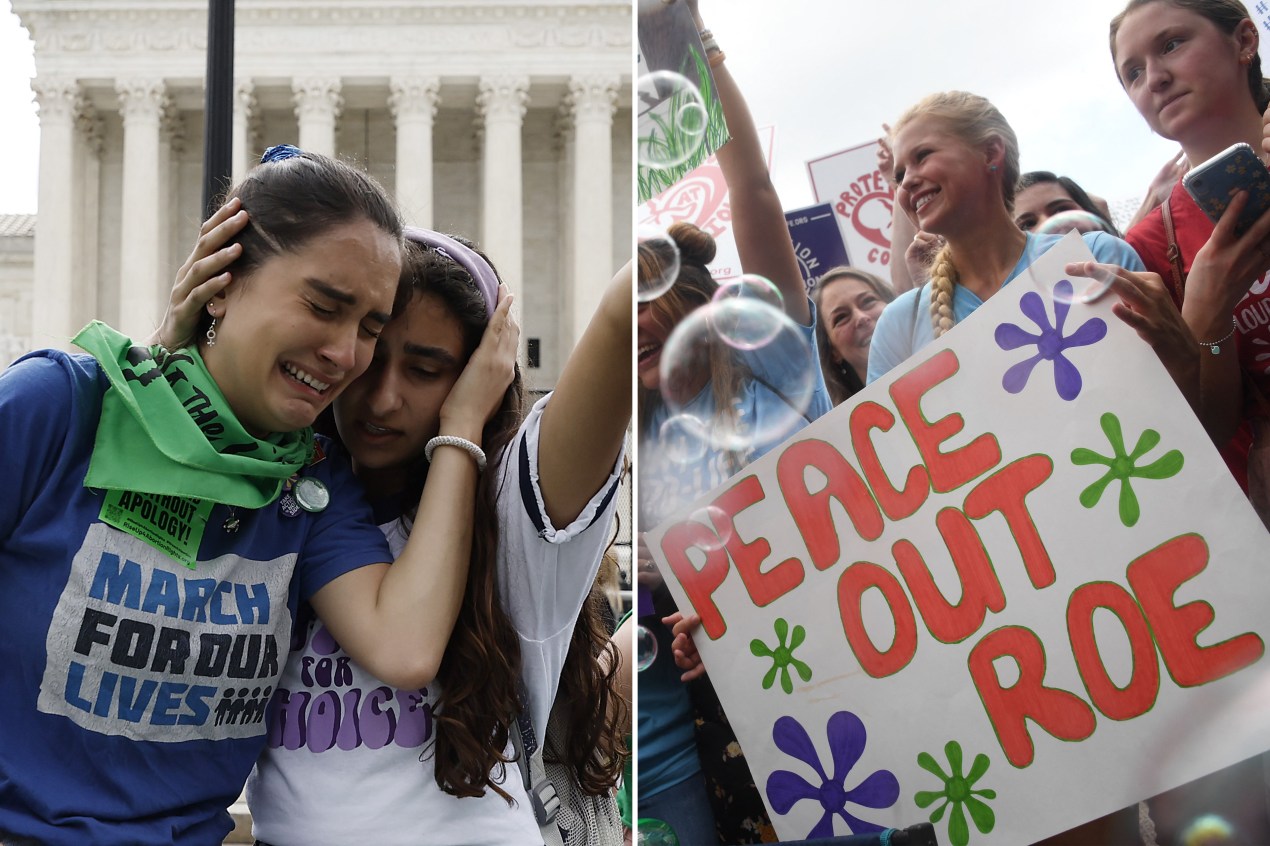[This article was last updated at 1:55 p.m. ET to reflect news developments.]
The Supreme Court on Friday formally overturned its 49-year-old landmark Roe v. Wade decision, and with it ended a half-century of constitutionally guaranteed abortion rights in the United States.
The 6-3 decision in the case, Dobbs v. Jackson Women’s Health Organization, was telegraphed in May by an unprecedented leak of an early draft of the majority opinion, written by Justice Samuel Alito. But even though the final, official version was slightly less strident than the leaked document, the impact is the same. The right to an abortion has been eliminated as if it never existed at all. The decision about whether to allow the procedure now falls to individual state governments, and only 16, plus the District of Columbia, have passed laws to preserve the option, while two others have state constitutional protections that have been cited by state courts as protections for abortion.
The majority opinion, whose signers included Justice Clarence Thomas and all three justices appointed by President Donald Trump — Neil Gorsuch, Brett Kavanaugh, and Amy Coney Barrett — said in no uncertain terms that 1973’s Roe, and a 1992 case that reaffirmed that right, Planned Parenthood of Southeastern Pennsylvania v. Casey, were wrongly decided.
“The Constitution makes no reference to abortion, and no such right is implicitly protected by any constitutional provision,” wrote Alito. “It is time to heed the Constitution and return the issue of abortion to the people’s elected representatives.”
Chief Justice John Roberts, an abortion opponent who had telegraphed when the case was argued in December that he was in favor of upholding the Mississippi law at the center of the case, agreed with the judgment but filed his own, concurring opinion in which he said he would not have gone as far. “I would take a more measured course,” he wrote. “The Court’s opinion is thoughtful and thorough, but those virtues cannot compensate for the fact that its dramatic and consequential ruling is unnecessary to decide the case before us.”
On the other hand, the three remaining liberal members of the court, Sonia Sotomayor, Elena Kagan, and Stephen Breyer, who is retiring at the end of this term, pulled no punches.
“One result of today’s decision is certain: the curtailment of women’s rights, and of their status as free and equal citizens,” wrote Breyer, in a dissent signed by all three of the liberal justices. “Yesterday, the Constitution guaranteed that a woman confronted with an unplanned pregnancy could (within reasonable limits) make her own decision about whether to bear a child, with all the life-transforming consequences that act involves. … But no longer. As of today, this Court holds, a State can always force a woman to give birth, prohibiting even the earliest abortions.”
It is hard to overstate the impact of the court’s action. While the Supreme Court has in the past reversed long-standing decisions, most notably in cases involving race relations, the court has never granted a right and then erased it.
In this case, the impact is also immediate. Thirteen states have so-called trigger laws that ban abortion, set to take effect upon Roe’s reversal. Other states have had pre-Roe abortion bans that could become active again, and some have post-Roe restrictions that are blocked by courts but could also take effect. In all, according to the Guttmacher Institute, which tracks reproductive health policy, 26 states are likely to ban or severely restrict abortion now that they are formally allowed to.
Reaction from those who support abortion rights was swift, although there is little they can do immediately to stop the wave of bans or restrictions. The House of Representatives has a majority of members who support abortion rights in at least some circumstances, but any legislation that would write abortion protections into federal law would lack the votes in the Senate to overcome a filibuster.
President Joe Biden, in a brief appearance a few hours after the decision was announced, said he disagreed strongly with the ruling. “It’s a sad day for the court and the country,” he said. “The health and lives of women in this nation are now at risk.”
Although his options are limited, Biden said that he would act to ensure that women in states that ban abortion can cross state lines to obtain the care and that the abortion pill approved by the FDA, mifepristone, would remain available.
Attorney General Merrick Garland expanded on that in a statement. “States may not ban Mifepristone based on disagreement with the FDA’s expert judgment about its safety and efficacy,” he warned.
But in the end, the only body that can reinstate abortion rights nationwide is Congress. “This fall, Roe is on the ballot,” Biden said.
And those on both sides of the issue are already gearing up. “Every single person who is running for anything is going to eat this decision for breakfast,” vowed Alexis McGill Johnson, president and CEO of Planned Parenthood.
“Today’s outcome raises the stakes of the midterm elections,” said Marjorie Dannenfelser, president of the anti-abortion group Susan B. Anthony Pro-Life America. “Voters will debate and decide this issue and they deserve to know where every candidate in America stands, including those who toe the Democratic Party line of abortion on demand without limits.”







